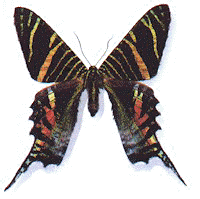Southbound in September
Flight of the Urania moth, search for Omphalea
By William G. Shultz
Smithsonian News Service
United States Southern Command "Tropic Times" September 22, 1995
For almost 30 years, Dr. Neal Smith has pursued an elusive goal. In the heat of the tropics, he has conducted basic research on the Urania moth in search of answers concerning its migratory behavior and its ancient relationship with the plant it's caterpillars rely on for food.
Smith's enthusiasm for the ongoing work seems boundless. Besides the value of understanding the moth and its food better, Smith and his colleagues have also discovered chemicals in the moth's food plant that may one day prove useful in the fight against human diseases, including AIDS and diabetes.
These chemicals, a class of alkaloids, may also be effective in eliminating insect pests that cause devastating crop losses and the resulting human suffering. Such discoveries are often among the unexpected results from basic research.
In his office at the Smithsonian Tropical Research Institute, headquartered here in Panama, Smith, a biologist, displays an array of Urania specimens. With their shimmering black and green wings and swallow-tails, these beautiful, day-flying insects look more like butterflies than moths.
Smith recalls his first day in Panama in 1963. The migrating moths were so abundant that year in Panama City, he said, he couldn't help noticing them and asking "what the butterflies were and where they were going." His secretary told him that no one knew where the "butterflies" came from or where they were headed. Smith has been asking questions about urania ever since.
"I can sometimes answer where they're coming from," Smith said. "I have a lot more trouble answering where they are going." In general, populations of the moths migrate from their northernmost occurrence in Mexico, south through lower Central America and northern South America, he said. The Urania are migrating because they are looking for the right kind of chemistry to produce the next generation of moths, Smith said.
"Whether there is another flight of Urania depends on the larvae," Smith said.
But because migration of a particular moth population is unpredictable, he said, it can be difficult to tell the origin of the migrating moths. The moths fly such great distances, some 60-100 miles a day, that determining their final destination is often impossible. The migration currently taking place is the first major rainy season flight since 1987, Smith said. Urania began crossing Panama from the Atlantic side Aug. 29-30. Smith noted that there was a large Omphalea plant near telephone pole 78 on the road to Fort Sherman.
Urania moths occur throughout most of the Western Hemisphere, not just the tropical Americas. Their source of food, as caterpillars, is a group of plants known as Omphalea. The moths live in the same places as the plant. This is more than a coincidence, Smith said. The world distribution of the moth and the plant Omphalea suggests an ancient relationship, one that stretches back to the time 280 million years ago when the land on Earth existed as a single continent.
The chemicals in I are known as "polyhydroxyalkaloids." In general, alkaloids are colorless, crystalline, organic substances usually found in plants. They can have a strong effect on insect nervous systems.
Chemists analyzed the alkaloids in Omphalea to determine if the compounds were active against insects or had other possible application, Smith said.
When the alkaloids were fed to rats, the rats lost weight. This finding suggests that the compounds might be effective in treating diabetes and obesity. Alkaloids have also been tested for activity against the human AIDS virus. In laboratory experiments, the compounds in omphalea have been effective in stopping the reproduction of the AIDS virus.
Aside from disease, Smith said, the alkaloids might help fight locust plagues that destroy crops and bring on devastating famines. The alkaloids seem to shut down the locusts' ability to migrate. Used as a pesticide, it could divert locusts from migrating.
The Omphalea also plays a significant role in the moth's migration, Smith said. As his research progressed through the 1960s and 1970s, he wondered if there are two types of Urania moths - sedentary and migratory.
Other insects, Smith learned, consume toxic or distasteful plant compounds - meant to protect against insect predators - and incorporate them as a defense against predators. Urania larvae eat and incorporate the polyhydroxyalkaloids in Omphalea, he said, perhaps to protect the caterpillars and the adults whose bright colors might invite predators such as wasps or birds to an easy meal.
The larvae build up a tolerance to the plant's toxins. "It looks like maybe they become addicted to the plant," Smith said.
Smith continues to study how migration is affected by the plant. The evidence so far indicates that the plant's biochemistry is the driving force behind the migration. It could be, he said, that the moth feeding on the plant slowly changes the plant's biochemistry. These changes are possibly the source for cycles in moth abundance and migration that occur every four or eight years.
Smith will continue his work, uncertain that the answers he seeks concerning the evolutionary relationship of Urania and Omphalea are truly in sight. Meanwhile, his probing questions may help solve human problems of equal complexity.
